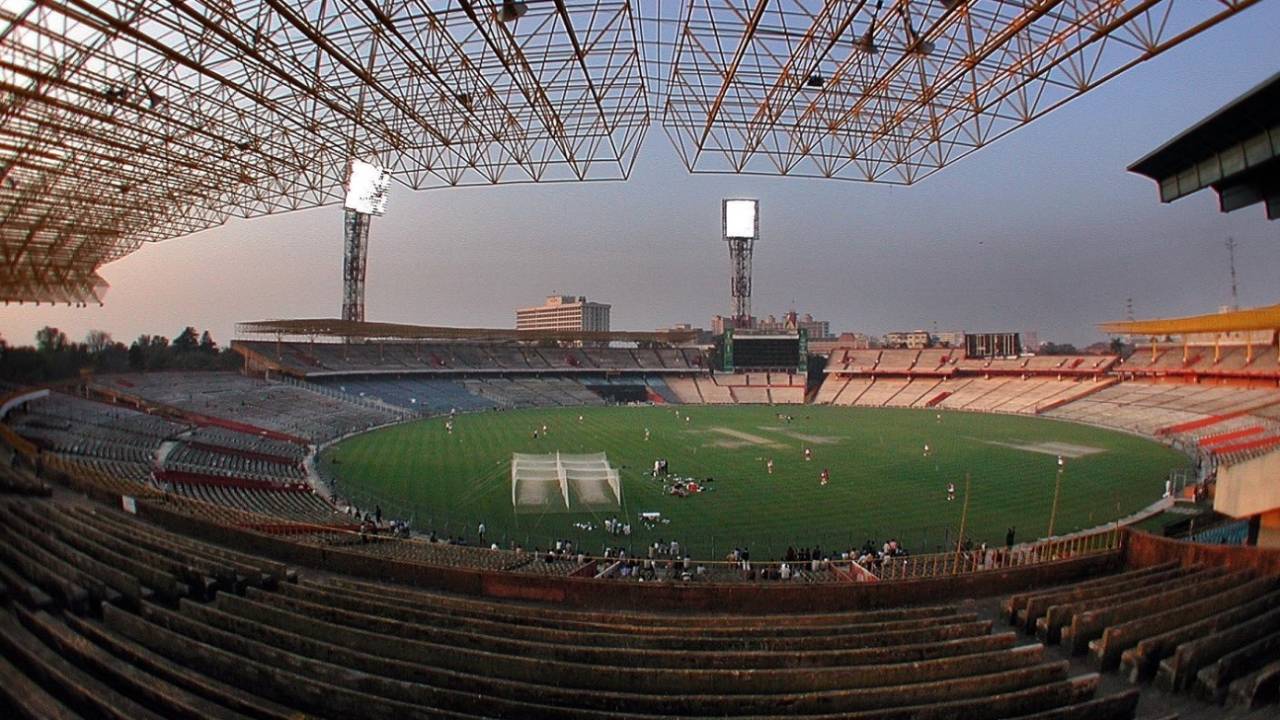FAQs: What's the big deal with pink-ball Tests?
Everything you've wanted to know and been too scared to ask
Nagraj Gollapudi
19-Nov-2019
Eden Gardens is set to host India's first day-night Test • Getty Images
On Friday, India and Bangladesh will both play their maiden day-night Test, at Eden Gardens in Kolkata. The Test coincides with the former India captain Sourav Ganguly completing one month as BCCI president. The day-night Test has been possible largely because of Ganguly - it was the first project he took charge of personally, and immediately (in his second day in the job) got the nod from Indian captain Virat Kohli, who he said agreed within "three seconds".
For Ganguly, day-night Test cricket has been a no-brainer ever since he was the head of the BCCI technical committee that had paved the way for the Duleep Trophy being played under lights in 2016.
Ganguly's support of day-night Test cricket stems from his belief that crowds will pour into the stadium in healthy numbers post office hours. It is another way to encourage fans to stay loyal to Test cricket. The development might have been abrupt, but it has now made the India players open up to a concept that has been accepted by most of the other major Test-playing countries.
Considering day-night Test cricket is still a new concept, here is a lowdown on some of the key factors that will come into play, factors that could eventually determine the result and the nature of the play.
What are the timings of the Test match?
The toss is scheduled at 12.30pm IST, with play starting half an hour later. The lunch break lasting 40 minutes will be between 3pm and 3.40pm, and the tea break, spanning 20 minutes, is from 5.40pm to 6pm.
Will there be anything different in the pitch?
Yes, the pitch plays a significant factor as always, but more so with the pink ball. Visibility is the most significant aspect while playing with the pink ball. For that, the ground staff have to ensure the ball is not roughened up or dirtied easily, as that would make sighting the ball difficult for both the batsmen and the fielding team. Hence there will be generous grass cover on the pitch and the outfield.
Sujan Mukherjee, the head groundsman at Eden Gardens, said he would maintain grass cover of 4mm on the pitch. For this Test, however, Mukherjee will maintain a 6mm grass cover, to help maintain the pink ball's sheen for as long as possible. This isn't as eyebrow-raising as the roughly 11mm of grass that was left on the Adelaide Oval pitch in the inaugural day-night Test between Australia and New Zealand in 2015.
Does that mean it will be a greentop?
No. Having a green grass cover is different to having green grass with moisture in the pitch. In the latter case, it will be a greentop. However, the grass cover at Eden Gardens would mainly serve towards maintaining the polish on the ball. According to Mukherjee, the other advantage for the bowlers is the "carpet-like" outfield which has been a unique factor at the ground since he took charge in 2016. Mukherjee said he has not done anything additional on the pitch, including rolling, which he says he does not do much of.

Which pink ball would you like?•Getty Images
What about dew?
Dew will play a huge role, though no one can pinpoint precisely how much. With the match being played in the Indian winter, and the sun setting pretty early in Kolkata (at about 4pm IST), dew is expected to set in from the beginning of the final session. Gripping the ball will become an issue if there is a lot of dew. One way to minimise the dew is to keep the length of the grass in the outfield minimal. And to make sure it stays dry. In order to achieve that, the ground staff stop watering the outfield a few days before the match.
According to Mukherjee, the dew has been "manageable" so far, in the lead-up to the match. He said he would start using anti-dew spray from Tuesday onwards.
What about the ball: Is the colour pink the only difference?
This won't be a debut just for the teams, but for the ball manufacturer SG as well. It will be the first time the SG pink ball is used in competitive cricket. There are few subtle differences to the red ball: the seam of the pink ball is stitched with a black thread as opposed to the white on a red ball. Since all all SG balls are hand-stitched, the seam is a bit more pronounced. Keeping the dew in mind, the seam is a bit more prominent in a pink ball.
Paras Anand, the marketing director at SG, said the seam is made of "durable" linen. Anand said there is extra lacquer on the pink ball. The lacquer is made up of a chemical material that provides the shiny look. "Other than the shine the extra coating is to protect the ball from any damage and also helps with the swing," Anand said.
Considering it is the first time the ball is being used, what about replacement(s) if the ball goes out of shape?
Match officials maintain what Anand calls a "library" of balls usually based on the usage in training and during a match. According to Anand, close to 8-10 dozens of SG pink balls have been distributed among both the teams in the past two weeks. He reckons the match officials and the BCCI would have maintained a library of the used SG pink balls from the training sessions that can be picked from if the match ball needs to be replaced.
If a batsman complains of bad visibility around twilight, how would the match officials deal with it?
The match officials have the option of turning the lights on early.
Nagraj Gollapudi is news editor at ESPNcricinfo
